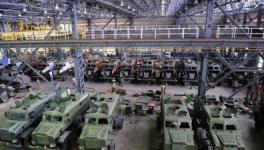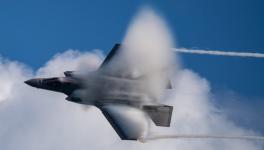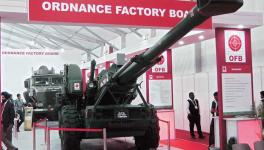The Air Force’s Strange Love for the New B-21 Bomber

Image Courtesy : Military.com
Did you know the U.S. Air Force is working on a new stealth bomber? Don’t blame yourself if you didn’t, since the project is so secret that most members of Congress aren’t privy to the details. (Talk about stealthy!) Known as the B-21 Raider, after General Doolittle’s Raiders of World War II fame, it’s designed to carry thermonuclear weapons as well as conventional missiles and bombs. In conceptual drawings, it looks much like its predecessor, the B-2 Spirit stealth bomber, all wing and no fuselage, a shape that should help it to penetrate and survive the most hostile air defense systems on Earth for the purposes of a “global strike.” (Think: nuclear Armageddon.)
As the Air Force acquires those future B-21s, the B-2s will be retired along with the older B-1B bomber, although the venerable B-52 (of the Cold War era), much modified, will remain in service for the foreseeable future. At $550 million per plane (before the inevitable cost overruns even kick in), the Air Force plans to buy as many as 200 B-21s. That’s more than $100 billion in procurement costs alone, a boon for Northrop Grumman, the plane’s primary contractor.
If history is any judge, however, a boon for Northrop Grumman is likely to prove a bust for the American taxpayer. As a start, the United States has no real need for a new, stealthy, super-expensive, nuclear-capable, deep-penetrating strategic bomber for use against “peer” rivals China and Russia. But before tackling that issue, a little history is in order.
Déjà Vu All Over Again
A long time ago (1977, to be exact), in a country far, far away, President Jimmy Carter did a brave thing: he cancelled a major Pentagon weapons system just before it was due to start production. That was the B-1 bomber, a plane with sophisticated -- that is, expensive -- avionics designed to allow it to penetrate Soviet airspace in the event of a nuclear war and survive. Carter cancelled it for the most sensible of reasons: it wasn’t needed.
The Air Force had already developed air-launched cruise missiles that allowed bombers like the B-52 to strike enemy targets with precision from hundreds of miles away. It was also, like all modern weapons systems, outrageously expensive. Why spend vast sums on a new bomber, Carter reasoned, when the plane added little to the nation’s nuclear deterrent? In addition, that cancellation was meant to send a message to the military-industrial complex -- that he would neither be beholden to nor intimidated by defense hawks who touted each and every new weapons system, no matter how expensive or redundant, as “essential.”
I was then a teenager with a yen for American warplanes. I’d even made a model of the B-1, complete with “variable geometry” wings that could be extended forward for low-speed flight and swept backward for high-speed, supersonic flight. In my mind’s eye, I can still see it, almost all white like the prototype that Rockwell International, its primary contractor, actually built. In a symbolic act of protest against Carter’s action, I took my model, taped a couple of firecrackers to it, and dropped it from the top floor of our house, blowing it up in a most satisfying way. So much for the B-1, I thought.
I was too young to know better. When Ronald Reagan became president in 1981, as part of a massive defense buildup (that Carter, ironically enough, had actually begun), he revived the B-1. The Air Force soon committed itself to buying 100 of them at a then-astronomical $280 million each. The B-1B Lancer (as it became known) has served in the Air Force for the last three decades, never (thankfully) fulfilling the purpose for which it was built: a nuclear attack. Plagued by accidents, high operating costs, and maintenance issues, the B-1 has been a disappointment to an Air Force now eager to replace it with an entirely new bomber, more or less guaranteed to have a similar history.
However much I loved the prospective plane as a teenager, I felt quite differently once I was myself in the Air Force. As a young lieutenant in 1986, I even wrote a paper for a contest within the service in which I argued that the concept of a manned, “penetrating,” strategic nuclear bomber was deeply flawed. In essence, I took the Carter position, suggesting that the other “legs” of America’s nuclear triad (ballistic missiles launched from silos and similar missiles on nuclear submarines) were more than enough to deter and defeat enemies (no less destroy the world), and that new “precision” technologies like cruise missiles rendered risky manned bombing missions deep into enemy airspace not just obsolete but antediluvian.
Not surprisingly, my paper didn’t win and the B-1B did. But it was an absurd addition, even by Air Force standards, given that the U.S. had an overwhelming arsenal of missiles at its command, together with a fleet of B-52s that, though lacking in speed and stealth, was aging rather well. In fact, B-52s are still flying today, which isn’t that surprising when you consider the development of highly accurate missiles that allow such a plane to “standoff” from targets and so limit its exposure to enemy air defenses.
Meanwhile, the Air Force, never a service to say no to expensive, high-tech weapons systems, no matter how redundant, was hard at work on a stealthy bomber that would achieve its vision of “global reach, global power, and global strike.” What emerged was the B-2 Spirit, a stealth bomber so expensive ($2.1 billion a pop) that only 21 were ever built. It was also pricierthan the B-1 to operate and less reliable thanks to its fragile “stealth” coatings, which required lengthy, high-cost maintenance. In other words, both planes proved expensive disappointments that, fortunately, were never tested on the primary mission for which they were built: incinerating millions of people in a nuclear war.
Enter the B-21, whose very name is supposed to indicate its cutting-edge nature, as the first bomber of a new century. It’s already being readied to reprise the grim, predictable histories of its predecessors.
Will the Bomber Go the Way of the Dodo?
Old ideas and hallowed traditions die hard, especially when they’re so lucrative for the military-industrial-congressional complex. Just look at the staying power of the disastrously overpriced F-35 stealth fighter, projected to cost $1.45 trillion over the life of the program. Put bluntly, today’s future-driven Air Force still wants to be capable of taking the fight to the enemy in a manned bomber, just as in the past. It still wants its air crews to put bombs on target. At a time when remotely piloted drones like the Predators and Reapers are rendering redundant so many human fighter pilots sitting in real cockpits, the Air Force has no intention of allowing its strategic bombing force to go the way of the dodo. Its leaders will always fight for manned strategic bombers because it fits their image of themselves: dodging enemy fighters, missiles, and flak, and taking the fight to the enemy’s doorstep.
In fact, not only does the Air Force want the B-21 as its “fifth generation” bomber, it also wants a new fighter jet to escort it on deep penetrating missions into China, Russia, or other countries. Think here of the legendary P-51 Mustangs, which accompanied U.S. strategic bombers deep into Nazi Germany during World War II. In other words, the Air Force’s vision of future aerial war bears an eerie resemblance to the action scenes in the classic 1949 war movie Twelve O’Clock High, except instead of the B-17s and P-51s of World War II, fifth generation bombers will join with sixth-generation fighters to claw their way through enemy airspace.
Of course, Pentagon officials have an array of talking points to support their case for the B-21. These include: maintaining parity, if not supremacy, vis-à-vis China or Russia or some future, ill-defined enemy and the need of our heroic troops for the latest and best in weaponry. They emphasize that canceling a major weapons system like the B-21 is tantamount to unilateral disarmament, that it would betray weakness to rivals and foes, and that manned bombers provide maximum flexibility since, unlike missiles, they can be recalled or redirected after being launched.
In truth, however, Twelve O’Clock Highscenarios look increasingly ridiculous and outmoded in the twenty-first century. But don’t tell that to the U.S. Air Force. When its strategists visualize bombers, all they see is potential, promise, and even fulfillment. But history shows us something else: the potential for widespread and indiscriminant destruction and massive casualties. If anything, since World War II, America’s arsenal of bombers has emboldened the U.S. to strike in places and in ways clearly counterproductive to just about any definition of national security, even as untold numbers of innocents have perished from the ordnance fired or dropped from those planes. The Vietnam War -- during which the U.S. dropped seven million tons of bombs -- is a perfect example of this.
Here’s the nightmarish reality of actually bringing such weapons systems online: when the U.S. military develops a capability, it seeks to use it, even in cases where it's wildly inappropriate. (Again, think of the massive B-52 bombings in Vietnam, Laos, and Cambodia in a counterinsurgency campaign classically meant to win “hearts and minds.”) Fielding a new strategic bomber for global strike, including potential thermonuclear attacks, will not so much enhance national security as potentially embolden future presidents to strike whenever and wherever they want in a fashion devastating to human life. The B-21 isn’t a force-multiplier. It’s an Armageddon-enabler.
Flying High in our B-21s
Having marketed himself as a savvy military critic, is there any possibility that Donald Trump will have the smarts of Jimmy Carter when it comes to the B-21 program? Will he save America at least $100 billion (and probably far more) while eliminating yet another redundant weapons system within the Department of Defense? Fat chance. Even if he wanted to, The Donald doesn’t stand a chance against the Pentagon these days.
Flush with billions and billions of new taxpayer dollars, including funds for those F-35s and for new nukes from a bipartisan coalition in an otherwise riven Congress, America’s military services will fight for any and all major weapons systems, the B-21 included. So, too, will Congress, especially if Northrop Grumman follows the production strategy first employed by Rockwell International with the B-1: spreading the plane’s subcontractors and parts suppliers to as many states and Congressional districts as possible. This would, of course, ensure that cuts to the B-21 program would impact jobs and so drive votes in Congress in its favor. After all, what congressional representative would be willing to vote against high-paying jobs in his or her own state or district in the name of American security?
So here’s my advice to young model-builders everywhere: don’t blow up your B-21s anytime soon. Rest assured that the real thing is coming. If the Air Force wants to ensure that it has a new bomber, in the name of blasting America’s enemies to oblivion, so be it. It worked (partially and at tremendous cost) in 1943 in the flak- and fighter-filled skies of Nazi Germany, so why shouldn’t it work in 2043 over the skies of who-knows-where-istan?
Why does “your” Air Force think this way? Not just because it loves big bombers, but also because its biggest rivals aren’t in Russia or China or some “rogue” state like Iran. They’re right here in “the homeland.” I’m talking, of course, about the other military services. Yes, interservice rivalries remain alive and well at the Pentagon. If the U.S. Navy can continue to build breathtakingly expensive nuclear-powered aircraft carriers (like the much-troubled USS Gerald R. Ford) and submarines, and if the Army can have all its tanks, helicopters, and associated toys, then, dammit, the Air Force can have what truly makes it special and unique: a new stealthy strategic bomber escorted by an even newer long-range stealthy fighter.
And don’t just blame the Air Force for such retrograde thinking. Its leaders know what’s easiest to sell Congress: big, splashy projects that entail decades of funding and create tens of thousands of jobs. As congressional representatives line up to push for their pieces of the action, military contractors are only too happy to oblige. As the lead contractor for the B-21, Northrop Grumman of Falls Church, Virginia, has the most to gain, but other winners will include United Technologies of East Hartford, Connecticut; BAE Systems of Nashua, New Hampshire; Spirit Aerosystems of Wichita, Kansas; Orbital ATK of Clearfield, Utah, and Dayton, Ohio; Rockwell Collins of Cedar Rapids, Iowa; GKN Aerospace of St Louis, Missouri; and Janicki Industries of Sedro-Woolley, Washington. And these are just the major suppliers for that aircraft; dozens of other parts suppliers will be needed, and they’ll be carefully allocated to as many Congressional districts as possible. Final assembly of the plane will likely take place in Palmdale, California, integrating components supplied from sea to shining sea. Who says America’s coastal enclaves can’t join with the heartland to get things done?
Even if President Trump wanted to cancel the B-21 -- and given his recent speech to graduates of the Naval Academy, the odds are that there isn’t a weapons system anywhere he doesn’t want to bring to fruition -- chances are that in today’s climate of militarism he would face enormous push-back. As a colleague who's still on active duty in the Air Force puts it, “What makes today worse than the Carter days is our flag-humping, military-slobbering culture. We can’t even have a discussion of what the country’s needs are for fear of ‘offending’ or ‘disrespecting’ the troops. Today, Carter would be painted as disloyal to those troops he was consigning to an early death because every procurement decision centers on a ‘grave’ or ‘existential’ threat to national security with immediate and deadly consequences.”
And so the Air Force and its flyboy generals will win the fight for the B-21 and take the American taxpayer along for the ride -- unless, that is, we somehow have the courage to pry the control sticks from the cold, dead hands of hidebound military tradition and lobbying firepower. Until we do, it’s off we go (yet again), into the wild blue yonder, flying high in our B-21s.
A TomDispatch regular and retired Air Force lieutenant colonel, William Astore taught history for 15 years at the Air Force Academy, the Naval Postgraduate School, and in Pennsylvania at a technical college. He’s never forgotten his visit to the Trinity site in Alamogordo, New Mexico, where the first atomic device was tested in 1945, nor his time in Cheyenne Mountain Complex, hunkering down under 2,000 feet of granite, waiting for a nuclear war that never happened. His personal blog is Bracing Views.
Get the latest reports & analysis with people's perspective on Protests, movements & deep analytical videos, discussions of the current affairs in your Telegram app. Subscribe to NewsClick's Telegram channel & get Real-Time updates on stories, as they get published on our website.
























